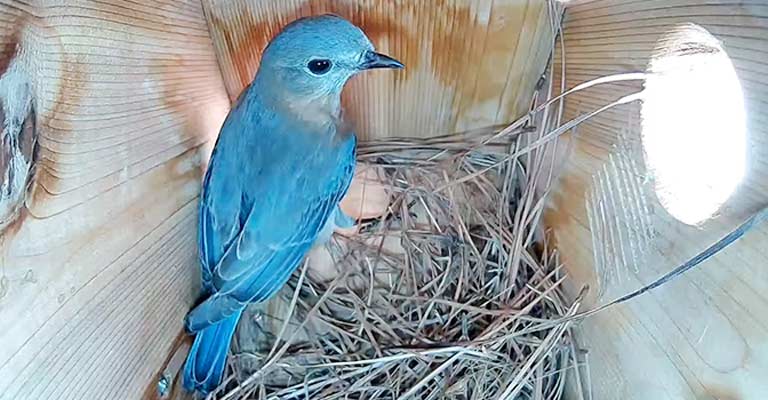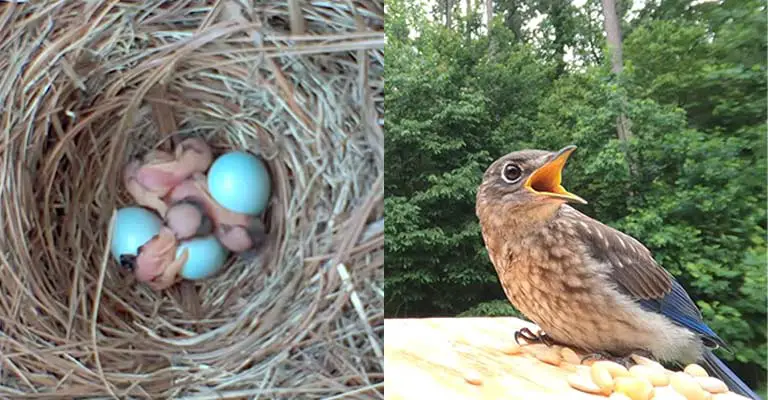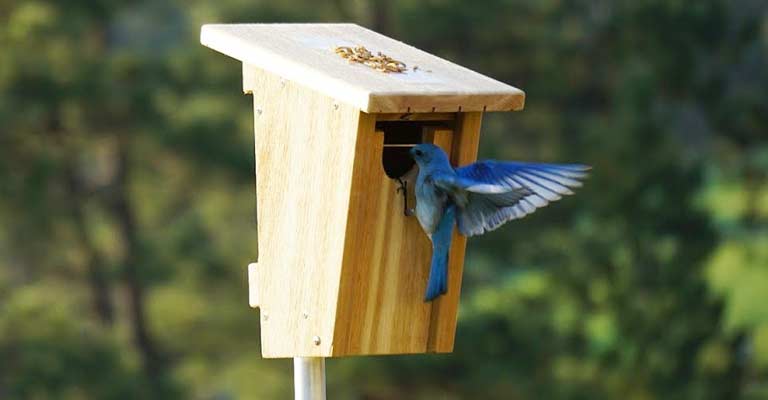In the heart of Eastern landscapes, a charming and vibrant species, the Eastern Bluebird (Sialia sialis), weaves its intricate tales of nesting habits. Delving into the secret lives of these feathered architects reveals a fascinating tapestry of nature’s design.
With their azure plumage and melodious songs, Eastern Bluebirds grace our surroundings while offering a captivating glimpse into their nesting rituals.
Nestled within the pages of this exploration, we uncover Eastern Bluebird nesting habits to witness the delicate interplay of pair bonding and marvel at the dedication these birds invest in raising their young.
From the choice of nesting sites to the selection of materials, every aspect of the Eastern Bluebird’s nesting habits tells a unique story of survival and continuity.
Join us on a journey through the intricacies of Eastern Bluebird nesting, where each twig and feather contributes to the delicate symphony of life in the aviary realm.

Eastern Bluebird Nesting Habits
Eastern Bluebirds (Sialia sialis) are not only renowned for their striking azure plumage and melodious songs but also for their fascinating nesting habits.
Nest Site Selection
The journey begins with the crucial task of choosing a suitable nesting site. Eastern Bluebirds are cavity-nesting birds, and while they naturally prefer abandoned woodpecker holes or natural cavities, they readily accept man-made nest boxes.
These boxes, strategically placed in open fields or edges of woodlands, have become vital in supporting their populations, offering a haven from predators.
Nest Construction
The artistry of nest construction showcases the bluebird’s meticulous nature. Typically, the female bluebird is the primary architect, meticulously selecting materials for the nest.
She gathers twigs, leaves, and grasses to create a cup-shaped structure within the chosen cavity. Feathers, often added for insulation, contribute to the nest’s warmth and comfort for the brood.
Pair Bonding and Courtship
The process of nest building is not just a solitary endeavor. Eastern Bluebirds are known for their strong pair bonds, which play a crucial role in the nesting phase.
Courtship displays involve the male bringing nesting material to the female, showcasing his suitability as a provider. This ritual strengthens their bond and sets the stage for successful co-parenting.
Egg Laying and Incubation
Once the nest is complete, the female lays a clutch of pale blue eggs, typically ranging from three to seven. The incubation period, lasting about two weeks, is a shared responsibility.
Both parents take turns keeping the eggs warm and protected. This cooperative effort exemplifies the commitment these birds exhibit toward their offspring.
Hatching and Nestling Stage
As the eggs hatch, revealing vulnerable hatchlings, the bluebird parents intensify their care efforts. In the early days, the nestlings were entirely dependent on their parents for sustenance.
The parents diligently feed them a diet rich in insects, ensuring the rapid growth and development of their young.
Fledgling Stage
The nestling stage culminates in the fledgling phase, where the young bluebirds leave the nest, testing their wings for the first time.
During this critical period, the parents continue to provide support and guidance, teaching their offspring essential survival skills. This phase marks the successful completion of a nesting cycle, as the fledglings embark on their journey into the world.
Threats and Conservation Efforts
Despite their resilience, Eastern Bluebirds face various threats, including habitat loss and competition for nesting sites.
Human intervention, through the installation of nest boxes and habitat preservation, has played a pivotal role in supporting bluebird populations.
Conservationists and enthusiasts alike actively participate in monitoring and maintaining nest boxes, contributing to the well-being of these charismatic birds.
Citizen Science and Monitoring
Engagement in citizen science initiatives, such as the monitoring of bluebird nest boxes, has become a popular way for individuals to contribute to conservation efforts.
By observing nesting activities, recording data, and addressing potential issues like invasive species or parasites, citizen scientists play a vital role in safeguarding the Eastern Bluebird’s nesting success.
How Long Does It Take Bluebird Eggs To Hatch and Leave Their Nests?

The journey from the moment a female Eastern Bluebird lays her eggs to the hatching of the tiny, vulnerable nestlings is a delicate and crucial period in the bird’s reproductive cycle.
Understanding the timeline of this process offers insights into the resilience and dedication required for successful bluebird reproduction.
Egg Laying
The first step in the process is the laying of eggs. Female Eastern Bluebirds typically lay one egg per day until the entire clutch is complete. A typical clutch size ranges from three to seven eggs, though it can vary.
The eggs are small, usually pale blue, and bear the characteristic shape common to many bird species.
Incubation Period
Once the clutch is complete, the incubation period begins. The female assumes the primary responsibility for incubating the eggs, although the male may take brief turns. The incubation period for Eastern Bluebird eggs lasts approximately 12 to 14 days.
During this time, the parent(s) maintain a constant temperature by sitting on the eggs to keep them warm. This crucial phase ensures the development of the embryos inside the eggs.
Role of Both Parents
While the female predominantly handles incubation, the involvement of the male is not negligible. The male may contribute to the incubation process by taking short shifts on the nest, allowing the female to feed and care for herself.
This cooperative effort reflects the strong pair bond between the mates and emphasizes the shared responsibility in preparing for the upcoming arrival of the hatchlings.
Days Leading to Hatching
As the days pass, the anticipation builds. Observers may notice increased activity around the nest as the parents prepare for the imminent hatching.
The attentive care given to the eggs intensifies during this period, with the parents often seen adjusting the nest, maintaining its cleanliness, and protecting the eggs from potential threats.
Hatching
The magic moment arrives when the eggs hatch, revealing the delicate, featherless hatchlings within. Hatching is a gradual process, with each chick breaking through its shell over several hours.
The chicks emerge blind, helpless, and entirely dependent on the care provided by their parents.
Parental Care of Nestlings
Following hatching, the demanding phase of caring for nestlings begins. Both parents take on the responsibility of feeding the hungry chicks, and providing a diet rich in insects to support their rapid growth.
The parents tirelessly shuttle between the nest and foraging areas, ensuring a constant supply of food for the nestlings.
Fledgling Stage
As the nestlings grow, they enter the fledgling stage, marked by the development of feathers and increased mobility.
This period usually occurs about 17 to 21 days after hatching. The fledglings venture out of the nest, testing their wings and gradually exploring their surroundings.
Parental guidance remains crucial during this phase as the young bluebirds gain confidence and independence.
Post-Fledging Care
Even after the fledglings leave the nest, the parental care continues. The parents teach essential survival skills, including foraging techniques and recognizing potential threats. This post-fledging care is vital for the young bluebirds’ successful integration into the wild.
How Do You Make an Artificial Eastern Bluebird Nest?

Before we start, select or purchase a suitable nest box designed specifically for Eastern Bluebirds. The box should have the appropriate dimensions, and entrance hole size (about 1.5 inches), and be constructed from weather-resistant materials.
If you’re making your nest box, you’ll need a piece of wood or PVC board. Ensure it is untreated and free from any harmful chemicals. Now, follow the steps given below:
Choose or Construct the Nest Box
Select a pre-made Eastern Bluebird nest box or follow the dimensions and design specifications if constructing your own. Ensure the box is made from safe, untreated materials.
If making your nest box, use a saw to cut the wood or PVC board into the necessary pieces. Typical pieces include a front panel, a back panel, two side panels, and a bottom.
Create the Entrance Hole
Drill an entrance hole in the front panel, approximately 1.5 inches in diameter. This size is suitable for Eastern Bluebirds.
Use screws to securely assemble the pieces, forming the nest box. Ensure the box is sturdy and free from any protruding screws that could harm the birds.
Paint or Stain
If desired, apply outdoor-grade paint or stain to the exterior of the nest box. Allow it to dry thoroughly before installing. If placing the nest box on a pole or tree, attach the appropriate mounting hardware to the box.
Select a Suitable Location
Install the nest box in an open area with a clear flight path for the birds. Position it at a height of 5-15 feet above the ground, preferably facing away from prevailing winds.
Add wood shavings or pine needles to the bottom of the nest box, creating a soft and comfortable nesting environment for Eastern Bluebirds.
By following these steps, you can create an artificial Eastern Bluebird nest box, providing a safe and inviting space for these beautiful birds to nest and raise their young.
FAQs
Why do Eastern Bluebirds prefer nest boxes?
Eastern Bluebirds have adapted well to using nest boxes for several reasons. The decline in natural cavities due to habitat changes and competition with other cavity-nesting species makes suitable nesting sites scarce.
How can I attract Eastern Bluebirds to my backyard?
To attract Eastern Bluebirds to your backyard, provide open spaces with short grass, install bluebird-specific nest boxes, and avoid using pesticides that could harm their insect prey.
Do Eastern Bluebirds reuse their nests?
Eastern Bluebirds typically do not reuse nests from one season to the next. After successfully raising a brood, they abandon the nest, and it is not uncommon for them to build a new nest for subsequent breeding attempts.
What is the role of male Eastern Bluebirds in nesting?
Male Eastern Bluebirds play a significant role in the nesting process. They assist the female in selecting the nest site, contribute to nest-building by providing materials, and share incubation duties.
How can I contribute to Eastern Bluebird conservation?
You can contribute to Eastern Bluebird conservation by installing and maintaining bluebird nest boxes, participating in citizen science projects that monitor bluebird populations, supporting habitat preservation initiatives, and avoiding the use of pesticides that could harm their food sources.
Conclusion
The Eastern Bluebird’s nesting habits offer a captivating narrative of resilience, resourcefulness, and the wonders of the natural world.
As we’ve unraveled the intricacies of their nest-building process and observed the commitment these birds demonstrate in nurturing their offspring, a deeper appreciation for the delicate balance of nature emerges.
The Eastern Bluebird, with its vibrant plumage and enchanting melodies, not only graces our landscapes but also serves as a reminder of the importance of preserving habitats.
As we reflect on the hidden dramas playing out in the treetops and meadows, let us celebrate the Eastern Bluebird’s role in shaping the biodiversity of the Eastern region.
May our appreciation for these small yet significant creatures inspire a commitment to safeguarding the environments that make such stories possible, ensuring that the Eastern Bluebird continues to enchant and thrive for generations to come.